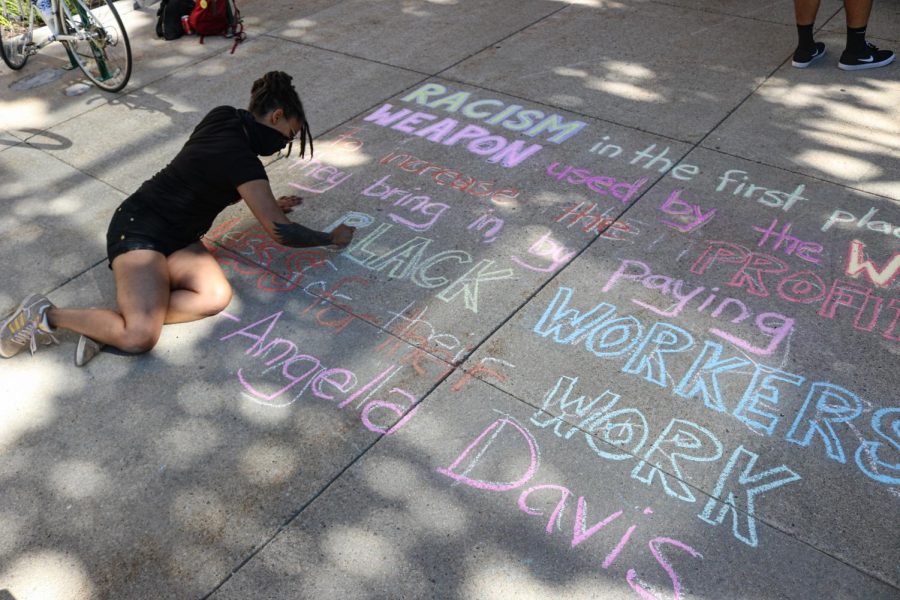Soter: Hire an Artist of Color, Destroy a Racist Monument
Attendee writes an Angela Davis quote in chalk at Washington Square Park for the Juneteenth celebration in Salt Lake City on June 19, 2020. (Photo by Ivana Martinez | Daily Utah Chronicle)
September 9, 2020
Fallen Monument Park in Moscow, Russia is full of statues of communist leaders, like Stalin and Lenin, who ruled Russia during the Soviet era. The park now commemorates the lives lost because of those leaders through the addition of more art, like a sculpture wall of stone heads behind a stone figure of Stalin. It honors the oppressed while acknowledging the horrors the oppressors committed. Russia has dealt gracefully with its past and its monuments.
Unfortunately, the U.S. can’t say the same. There are nearly 800 Confederate monuments still standing across the nation, not to mention the hundreds of other honorary symbols and tributes dedicated to the “Lost Cause.” The messages of the Confederacy that still linger present a great contradiction: if monuments (according to Merriam-Webster) are meant to memorialize “something notable or great,” why do we tolerate those that memorialize the most horrendous part of our nation’s past, the Confederacy? It seems obvious that the violence and racism of the Confederate Army is something we should look down upon, not up toward.
As the debate over Confederate statues escalates in our nation due to protests around police brutality and racism, we have been forced to reckon with the ways we navigate and address our tangibly racist history. People have differing ideas about what that should look like. In fact, when I started my research for this article, I was stuck in the middle of the debate.
On one hand, keeping our history in mind is an important way of holding ourselves accountable as we strive for a more equitable future. On the other hand, these monuments honor our racist past; the fact that they still stand is in and of itself an obvious mark of how little the country has evolved. Confederate statues showcase vicious men on their horses as if they were deserving of high praise when in reality they are shameful markers of our inhumane history. We should all want to erase them. It made me think: how can we portray these white supremacists for what they truly were rather than giving them a place in communities that should be held by legitimate champions of justice and social progress? There’s an alternative that gives us the opportunity to remember the monuments while also destroying them, at least in a sense: art.
Art has played a powerful role in social movements throughout history, as it is now. Artworks ranging from Dr. Seuss’s political propaganda to Buffalo Springfield’s famous song “For What It’s Worth” to the portraits and murals of George Floyd popping up in cities nationwide make that very clear. It is art that informs us about the truth of social movements and how we should be reacting. Take, for example, Ai Weiwei and his work inspired by the 2008 earthquake in Sichuan. Weiwei’s piece raised awareness of China’s negligent response to the tragedy and launched him into a life of activism. This is just one of many examples depicting the power art can have to affect social change.
Artists trailblaze social movements through their vulnerability, honesty and compassion. Like all activists, many political artists draw heavily on their personal stories, leading to artworks that can become symbols for social movements. Seeing the first-person perspective of suffering caused by injustice, inequality and oppression forces the viewer to look within for empathy, and ultimately recognize others’ humanity.
So what does this all mean for the fate of Confederate monuments? The recently vandalized statue of Robert E. Lee in Richmond, Virginia might be a good model for how to move forward. The intent of the vandalism was to get the massive monument torn down, not to be recognized as a profound work of art, but it was — and it robbed the monument of any respect it once had. For the sake of irony, it’s worth noting that Robert E. Lee himself never supported Confederate monuments. In fact, he was quoted as saying, “I think it wiser, moreover, not to keep open the sores of war but to follow the examples of those nations who endeavored to obliterate the marks of civil strife.” Perhaps Lee had a point. These statues need to be “vandalized” to showcase just how sickening they are. City councils could hire local artists to do the vandalizing — or transforming, rather. Ideally, those artists would come from communities that have historically been oppressed or excluded because of the systemic racism within our society. Just as important, racist monuments’ existing plaques should be replaced with the true and complete histories of the people they embody or commemorate. This way it would be clear that the intent is not to falsely honor racists or racism — we’re being honest.
This solution is a compromise to the Confederate statue debate. Many argue that if we destroy these monuments, we will be wrongly removing a page of our history book. Unfortunately, white supremacy and racism are not only a part of our history — they are a part of our present. Transforming racist monuments into art that reflects the truth about these figures is a way of acknowledging our current reality. And for those who believe these shameful reminders of our history should be destroyed, this idea accomplishes that too — just in a new way.








